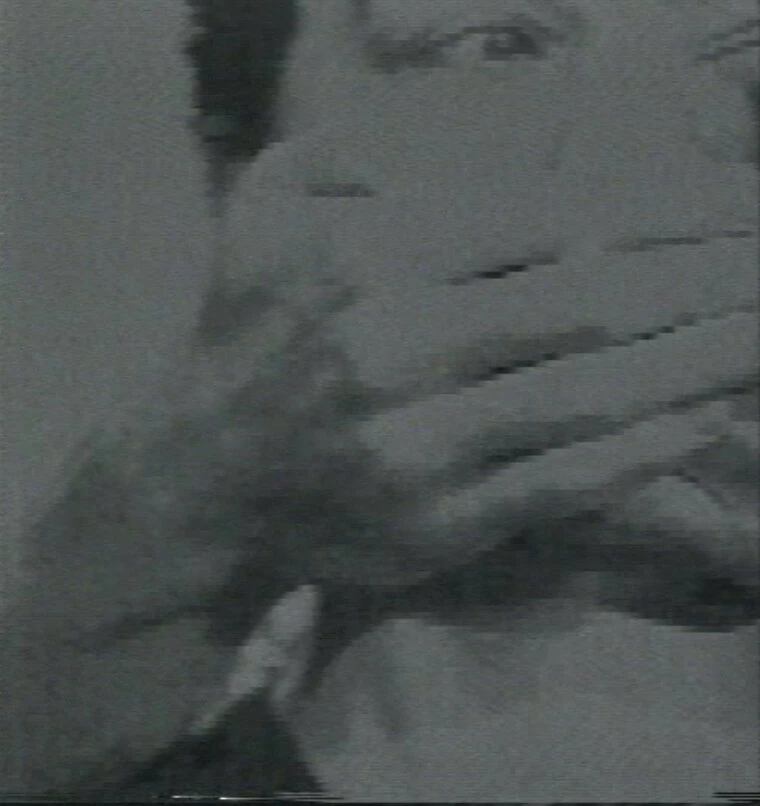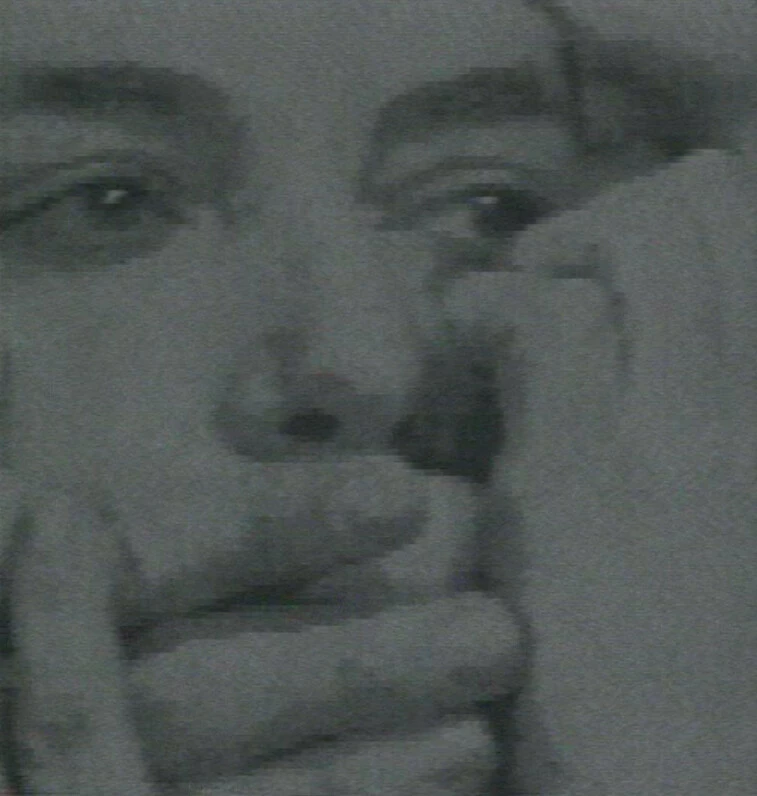The Vagina Dentata; or, Bodies-in-Pieces
by Mariana Fernández
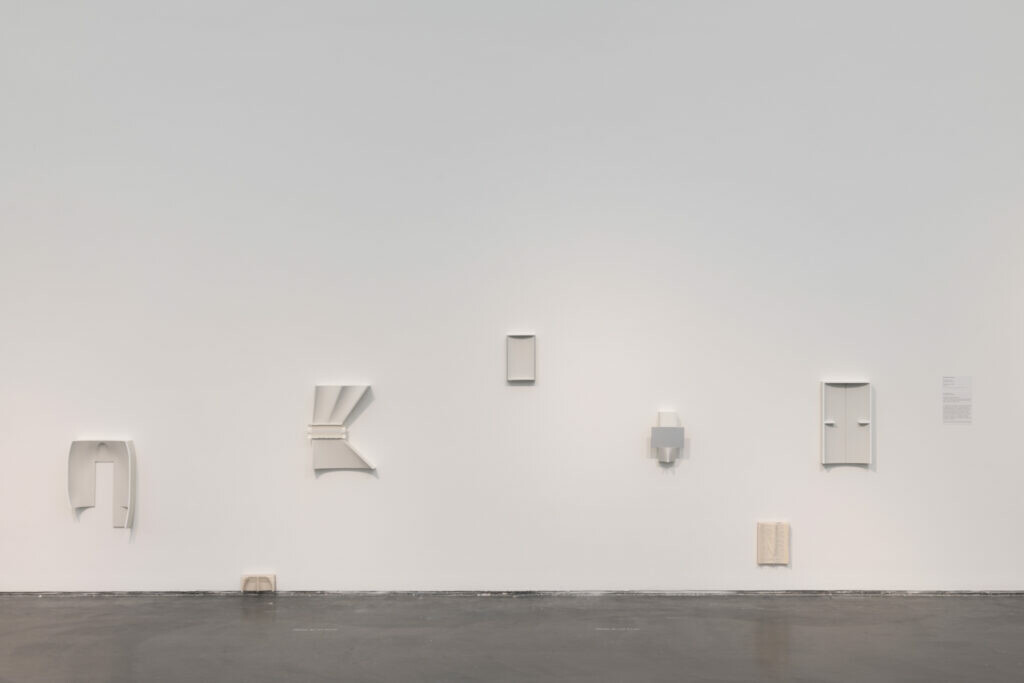
B. Ingrid Olson, Projection, Body Parsed, 2018. Vinyl paint, enamel paint, latex paint, polyurethane foam, medium-density fiberboard, PETG plastic, fabric, plywood, and screws; seven parts, dimensions variable. Collection Museum of Contemporary Art Chicago, gift of Katherine S. Schamberg by exchange and restricted gift of Donna Stone, Ashlee Jacob, Matthew S. Ozmun, Sara Albrecht, and Jim Karr, 2020.4.a-g. Installation view, Dependent Objects, MCA Chicago, March 6–August 1, 2021. Photo: Nathan Keay, © MCA Chicago.
The MCA DNA Research Initiative is a multi-year curatorial program, supported by the CHANEL Culture Fund, that invites early-career curators and writers to the museum for interdisciplinary research projects related to the institution’s collection. Focused on the intersection of visual art and performance, this initiative surfaces overlooked art historical narratives within the organization’s history while foregrounding the cross-disciplinary ethos that has been integral to the museum since its founding in 1967. The following essay was written by program participant, Mariana Fernández, upon the conclusion of her research project.
In the summer of 1997, Mona Hatoum’s first US exhibition opened at MCA Chicago. The centerpiece of the show was a cylindrical booth, an installation of Hatoum’s Corps étranger (1994). Viewers entered through one of two vertical slits on either side of the viewing chamber to find themselves immersed in the pulsing, bass-like soundtrack of a recorded human heartbeat. Within this narrow space, endoscopic footage of Hatoum’s body was projected on the floor: first tracing recognizable surfaces like skin and hair before plunging deep into the fleshy pink tubes, yellow gastric juices, and dark orifices of her bowels. Through the succession of extreme close-ups in which folds and membranes were transformed into plateaus and caves, the fast-paced footage became increasingly disorienting. The multivalent “foreign body” of Hatoum’s French title represents a radical assault upon the space of bodily representation, refusing the viewer’s comprehension by presenting Hatoum in cropped, ambiguous, and unsettling embodied episodes.
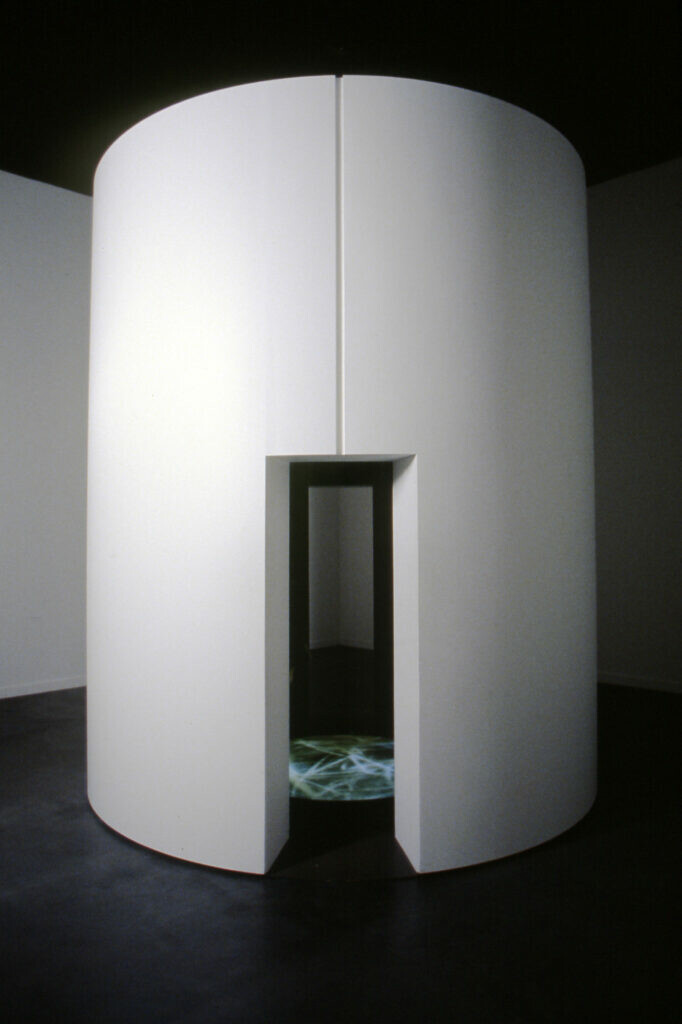
Mona Hatoum, Corps étranger, 1994. Cylindrical structure with video projector, videotape (color, sound), and four speakers. Installation view, Mona Hatoum, MCA Chicago, July 18–September 14, 1997. Photo: Joe Ziolkowski, © MCA Chicago.
We could understand this disorientation of Hatoum’s body—melding and separating parts from one another and estranging them beyond recognition—as akin to the symbol of the vagina dentata. The “toothed vagina,” as it is translated from Latin, reflects an age-old trope of the female body as a site of danger and terror. The vagina dentata manifests across history and culture in many forms: as a castrated and thus incomplete body in Freudian theory, as the ruler of the underworld in Māori stories, as the monstrous Scylla who boasts vicious dogs below her waist, or as the Gorgon whose writhing visage—evocative of the vulva1—is, in the words of Barbara Creed, “alive with images of toothed vaginas, poised and waiting to strike.”2 In art history, Caravaggio’s beheaded Medusa (1597) or Courbet’s notorious L’origin du monde (1866), depicting a woman’s exposed vulva with her head out of sight, similarly represent moments of intense conflation where feminine embodiment is presented in uncertain and incomplete terms.
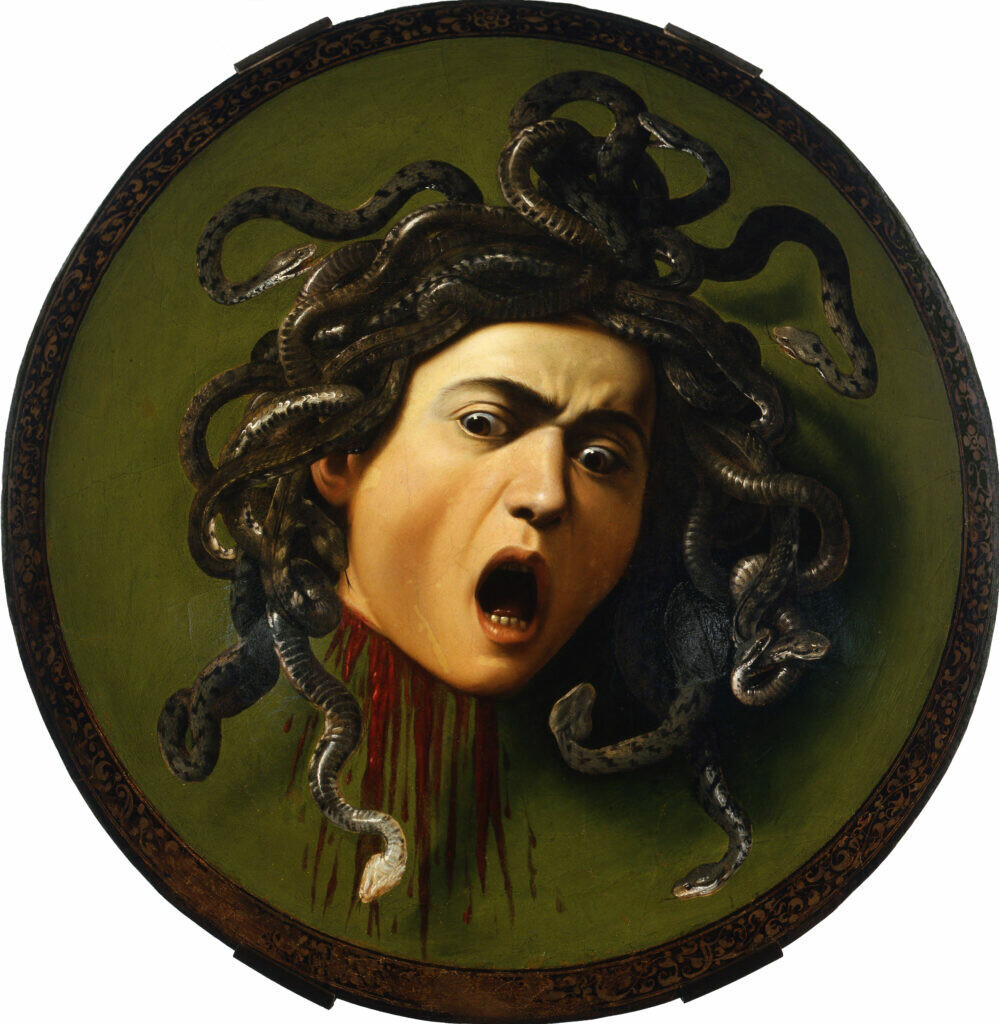
Caravaggio (Michelangelo Merisi da), The Head of Medusa, 1590–1600. Oil on canvas glued to wood; diam: 21 5/8 in. (55 cm). Uffizi Gallery, Florence. Photo: ARTGEN/Alamy.
What is significant about these various representations—beyond the misogynism of the exoticized and demonized woman—is the fear associated with the unknowable body. Like Hatoum’s Corps étranger, the toothed vagina signals a female body defamiliarized and made grotesque through subverting assumptions about its form—the polar opposite of traditional depictions of the female nude in the Western canon, from Venus to Olympia. The one unifying factor among the vagina dentata’s various representations is the depiction of the body as a symbol of both fracture and confusion. As the critic and poet Susan Stewart writes, such a grotesque body is a “a body of parts”: an image of a body, in other words, that refuses to behave, to cohere into logical order.3
In the MCA Collection, several works reveal that there are resources to be found in the plasticity of this image for renegotiating the terms of the body’s display. Works in installation and video by B. Ingrid Olson, Ann Hamilton, and Mona Hatoum take up the fragmentation and abstraction of the vagina dentata to subvert both traditional representations of form and static categories of identity that have dominated art history. By staging distortions, multiplications, and fractures, each artist approaches the contested depiction of the female body as a multiplicity of adaptive parts, proposing malleable and indeterminate understandings of selfhood as they wrestle with and against representation.
A core concern across these works is a contested tension between the “real” body and its image. With the rise of imaging technologies over the last half century, we have experienced a dramatic shift in the production and circulation of representations of the body as extensions of the “self.” But as critic and curator Amelia Jones states in her book Self/Image, “the body” is a mutable entity, marked by—yet too often reduced to—various expressions of gender, race, class, ability, and so forth. In Jones’s formulation, we cannot rely on individual images to be “coincident with a ‘real’ or ‘live’ body that secures a stable, coherent, or recognizable self.”4 Rather, “representation points to the impossibility of the ‘real’ ever being known” outside of the subject’s own embodied experience.5 In other words, attempting to represent the “whole” inevitably fails to account for selfhood’s multifaceted nature. Particularly as assumptions and understandings of race, class, and gender are placed on the body, the concept of vagina dentata—as a refusal of anatomical comprehension—plunges us into a space of resistance and subversion where the body can exist as a hybrid entity with the ability to change, evolve, and mutate.
Corps étranger embodies the vagina dentata’s instability through its use of fragmentation and disorientation—strategies that numerous artists have taken up to similarly stage an estrangement of the body and underscore the limits of its representation. In B. Ingrid Olson’s seven-part installation Projection, body parsed (2018), the artist presents an index of different body parts that have been geometrically abstracted into minimalist wall reliefs. Concave and convex shapes of various scales allude to different anatomies through their placement on the wall: a slim rectangular form hung at navel height, for instance, casts a pointed shadow that hints at genitals—though clues about the body’s gender are deliberately omitted. The installation comes with a set of instructions that dictates each sculpture be hung at the height of the installer’s corresponding body part, thereby replacing the specificity of the artist’s body with that of the person hanging the work.
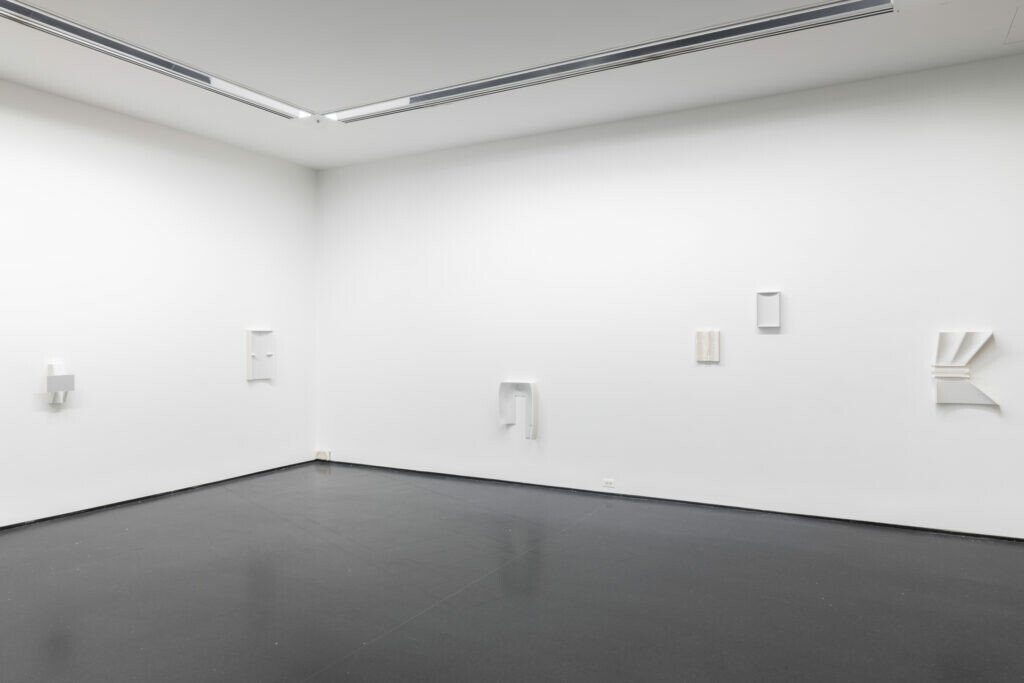
B. Ingrid Olson, Projection, Body Parsed, 2018. Vinyl paint, enamel paint, latex paint, polyurethane foam, medium-density fiberboard, PETG plastic, fabric, plywood, and screws; seven parts, dimensions variable. Collection Museum of Contemporary Art Chicago, gift of Katherine S. Schamberg by exchange and restricted gift of Donna Stone, Ashlee Jacob, Matthew S. Ozmun, Sara Albrecht, and Jim Karr, 2020.4.a-g. Installation view, Dependent Objects, MCA Chicago, March 6–August 1, 2021. Photo: Nathan Keay, © MCA Chicago.
While prescriptive in one sense, Olson’s installation instructions invite an opportunity to reconsider the one-to-one relation between the self and its image. On the subject of self-portraiture, the artist remarked: “However funny it may sound, I rarely, if at all, think about persona, or myself as a self when I make work…I approach my body as a material with which to make images, capturing fragments of my own body as a marker of occupied space.”6 Olson’s attention to the body in relation to boundaries and space becomes a means not of flattening embodied experience, but of attending to the multiplicity of selves interacting with the work. Refusing both figuration and complete abstraction, the forms invite viewers to “complete” the image with whatever narratives and possibilities inform their projections. The installation’s instructions are entirely open-ended in terms of ordering and distance between sculptures, suggesting a body that can be endlessly revisited and reworked.
In Olson’s related photographic works—confusing images that feel both far away and confined—the lens is a mirror that simultaneously fragments and multiplies the artist’s body. Olson said in a recent interview: “I always consider the viewer’s encounter with my work, attenuating when and how much of the image is revealed.”7 In other words, Olson choreographs a kind of slow, time-based encounter between viewer and subject. Cuirass (2023), for instance, features an image of cardboard and creased packing tape layered beneath a smaller image of the artist’s breast pressed against a soft transparent tube. The interior of the tube acts like a mirror, refracting the areola into a strange rippling, bulbous form. The body’s extreme confinement in this frame results in its illegibility, allowing it to escape entrapment in representation. Rather than attempt to overcome its limits, the image revels in the fissure that inevitably sits between the experience of viewing the body and the body itself. The process of trying to work out what we are looking at pushes us into a constantly shifting interaction between our own subjectivities and the image’s experienced contents.
This fluctuating relationship between viewer and image is the very site of the vagina dentata, an image that pushes against representation as a site of reified interpretation. Describing Corps étranger in the catalog accompanying Hatoum’s 1997 exhibition at the MCA, curator Jessica Morgan wrote that “by confusing the boundaries of the body and never presenting the figure complete, Hatoum denies the viewer’s conventional desire to visualize the entire form and thus to create an ordered whole on which to project him- or herself.”8 Through the filmic endoscopy that offers passage through the canals of digestive and reproductive systems, Hatoum scatters and redistributes the body into a series of massively enlarged parts that seem to recede into abstraction. To follow Jones in appealing for “images of the body that are immersive rather than safely contained, bounded, and thus potentially trapped by an external gaze,” Hatoum’s various anatomies swirling on the floor generate an even greater phenomenological encounter than a “coherent” representation of her body would.9 The artist herself, invoking the symbol of uncontrolled female corporeality, commented on how the work stages “a wonderful paradox between woman as victim and woman as devouring vagina.”10 Like the vagina dentata—grotesque, terrifying, seductive, and unstable—Corps étranger presents a body that refuses to cohere into legibility, a body that exceeds the confines of its own image.
In these ambiguous viewing situations, with the self no longer tethered to its image, connection between illegible subjectivities may feel like a futile effort. When this crisis of representation began to be interrogated by artists using video in the 1960s and 1970s, critic Rosalind Krauss’s 1976 essay “Video: The Aesthetics of Narcissism” emerged as a paradigmatic text on the medium. Krauss charged that video, specifically performance for the camera, uses “the human body as its central instrument” in order to isolate the subject.11 According to Krauss, this centering of the body coupled with a unique capacity for instant feedback render the medium inherently narcissistic, perpetually stuck in a “collapsed present” where the self is “understood to have no past, and as well, no connection with any objects that are external to it.”12 Live feedback essentially traps the artist within a mirror-reflection that can only exist within the monitor and the camera; it surrounds the self with the self in the “psychological condition” she defines as clinical narcissism. Yet Corps étranger, and many other works by female artists who use performance for the camera to examine and edit identity, complicate Krauss’s position by employing the very gestures she associates with video’s narcissism.13 Looping time and bracketing-in the body, or parts of it, between the monitor and camera become means of dissolving the coherent self-image, projecting instead plural selves that echo personal and shared realities.
Take Hatoum’s early work So Much I Want to Say (1983), which was originally performed live in Vancouver and transmitted to Vienna via slow-scan television (SSTV) and a telephone line. The video in the MCA Collection shows tightly framed, alternating images of Hatoum’s face, partially obscured by an unidentified pair of large, possibly male hands gagging her mouth and preventing her from speaking. In a voice-over, she utters the phrase “so much I want to say” again and again. Hatoum’s repetitive actions within the feedback loop suggest a persistent silencing—perhaps a reflection of the artist’s own political voicelessness as a Palestinian born in Lebanon and living in London, or of experiences of gender disparity in the 1980s, or a comment on the British society or the art worlds she found herself navigating. The work echoes the earlier short film Y (1974) by Anna Maria Maiolino, which pairs claustrophobic images of the artist’s open mouth with dissonant sounds of muffled and high-pitched screams, or Theresa Hak Kyung Cha’s Mouth to Mouth (1975), which similarly presents the body as both partial and excessive by dissolving tight shots of the artist’s moving mouth into video static. In each instance, the struggle between embodiment and fragmentation is not a means of “bracketing out the world,” but rather uses video technology to accommodate a self not willing, or not able, to settle into fixed forms.14
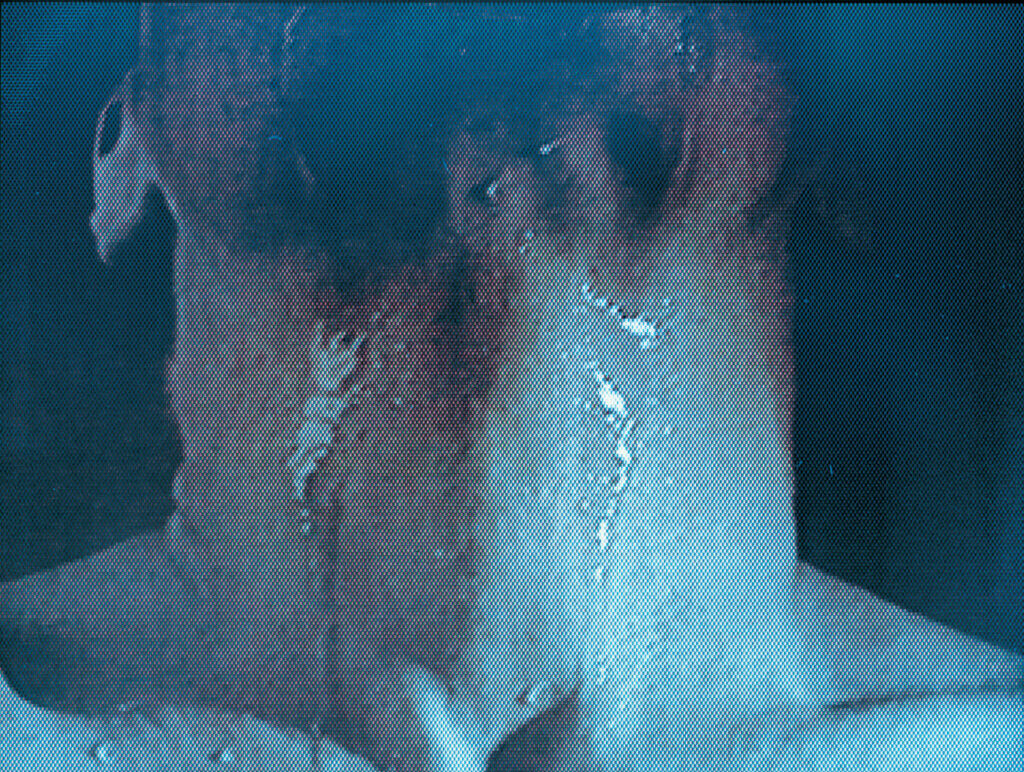
Ann Hamilton, (dissections…they said it was an experiment.video), 1988–1993. LCD monitor with color-toned image, 30-minute video laser disc, and laser disk player; screen: 3 1/2 × 4 1/2 in. (8.9 × 11.4 cm). Collection Museum of Contemporary Art Chicago, Bernice and Kenneth Newberger Fund; restricted gift of Susan and Lewis Manilow and Howard and Donna Stone, 1995.13. Photo © MCA Chicago.
Strategies of bodily expansion and confinement make another appearance in four intimately scaled video works by Ann Hamilton in the MCA Collection. For Hamilton, who is best known for multisensory, large-scale installations, video specifically presents “a way to introduce a gesture that can’t be performed live or can’t be ongoing.”15 Video’s looping time is a means not just of prolonging a gesture, but of shaping the viewer’s perception of it. Her first video was presented in the 1988 installation Dissections…they said it was an experiment at Artists Space in New York, where a tiny monitor displayed looping footage of water continuously running down a tightly framed neck. Dissections was editioned as a stand-alone video in 1993, along with three others that also show close-ups of body parts overflowing with matter: water pouring into an ear in (the capacity of absorption · video) (1988/93), water flooding a mouth in (linings · video) (1990/93), and stones rolling around inside a mouth in (aleph · video) (1992/93). Each video isolates an orifice of the body—the mouth or ear—reduces its scale, and compromises its ability to speak or hear. Hamilton, whose installations frequently juxtapose the miniature and the gigantic, specified that each of the four editioned videos be “scaled to intimacy” by always being shown on a flat screen monitor of 3 1/2 by 4 1/2 inches embedded flush into the wall.
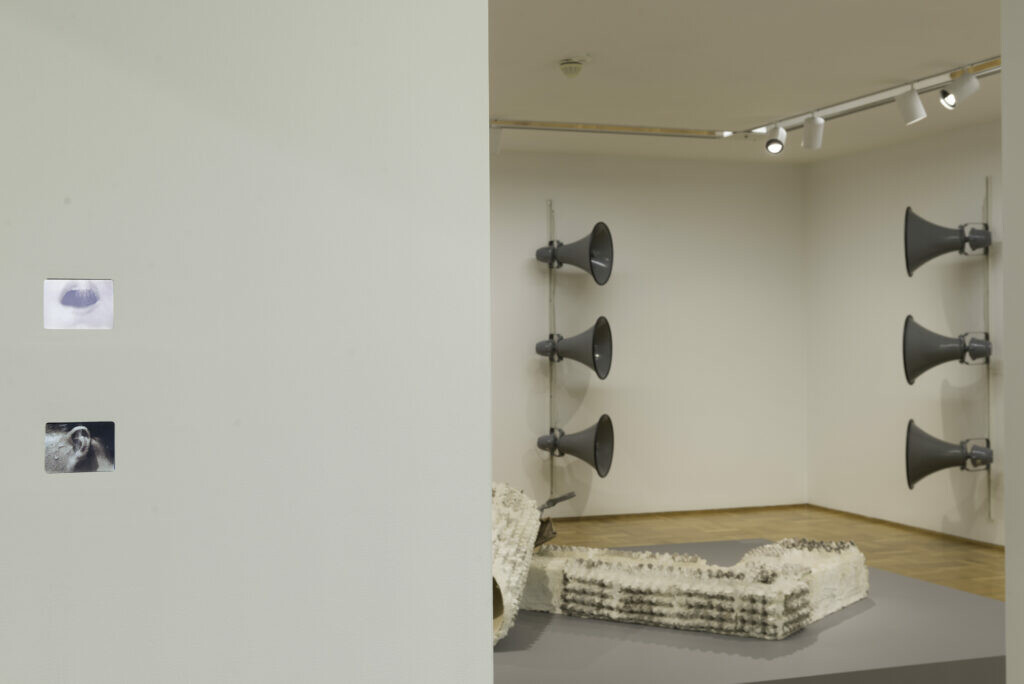
Works shown: Ann Hamilton, (dissections…they said it was an experiment · video), 1988–1993; LCD monitor with color-toned image, 30-minute video laser disc, and laser disk player; screen: 3 1/2 × 4 1/2 in. (8.9 × 11.4 cm). Collection Museum of Contemporary Art Chicago, Bernice and Kenneth Newberger Fund; restricted gift of Susan and Lewis Manilow and Howard and Donna Stone, 1995.13. Ann Hamilton, (linings · video), 1990–93. LCD monitor with color-toned image, 30-minute video laser disc, and laser disc player; screen: 3 1/2 × 4 1/2 in. (8.9 × 11.4 cm). Collection Museum of Contemporary Art Chicago, Bernice and Kenneth Newberger Fund; restricted gift of Susan and Lewis Manilow and Howard and Donna Stone, 1995.14.
Installation view, Can You Hear Me Now?, MCA Chicago, April 27–September 29, 2019. Photo: Nathan Keay, © MCA Chicago.
Scale again functions as a means of creating a sense of bodily ambiguity. Especially in the context of the full-wall projections artists were beginning to use in the 1990s, these tiny screens brought viewers into unusual proximity with the simple gestures on loop in Hamilton’s videos. The body parts on camera are not much smaller than an actual neck, mouth, and ear, turning the focus away from the performance on video to the viewer’s embodied experience of the work. Hamilton captures and isolates fragments of the body with hypnotic simplicity and confounds their normalized functions so as to estrange the viewer from everyday actions. And through this dual estrangement and closeness, she—like Hatoum and Olson—incorporates foreignness into the body. Her miniaturized anatomies are the reversal of Corps étranger’s engrossing scenes of enlarged body parts, yet both works heighten the viewer’s own corporeal awareness by performing and presenting the body as other, strengthening a connection with the viewer’s own subjectivity beyond fixed labels and identities.
In these various images of bodies-in-pieces across artworks and mediums, the indeterminacy of the vagina dentata is recast as a means of potential liberation from the static terms of portraiture that restrict subjectivity. The false idea of being able to project a self-contained, singular “I” through representation is replaced with an understanding of selfhood as something each of us has, yes, but also as something all of us have, something collective. The works force us to turn inward, to imagine what possibilities might fill the glitches or empty spaces—and in the process begin to question what gaps might exist in our own imagination and empathy.
Footnotes
1. See Julia Kristeva, The Severed Head: Capital Visions, trans. Jody Gladding (New York: Columbia University Press, 2012), 29.
2. Erin Harrington, Women, Monstrosity, and Horror Film; Gynaehorror (London and New York: Routledge, 2018), 52–55. Marianne Govers Hopman, Scylla: Myth, Metaphor, Paradox (Cambridge: Cambridge University Press, 2013), 12–13, 138–39. Barbara Creed, The Monstrous-Feminine (London and New York: Routledge, 1993), 106, 111.
3. Susan Stewart, On Longing: Narratives of the Miniature, the Gigantic, the Souvenir, the Collection (Durham, NC: Duke University Press, 1992), 105.
4. Amelia Jones, Self/Image: Technology, Representation, and the Contemporary Subject (London and New York: Routledge, 2006), 21.
5. Jones, 85.
6. Interview with B. Ingrid Olson in Jeune Otte: https://www.jeuneotte.com/journal-pages/b-ingrid-olson.
7. B. Ingrid Olson interviewed by Jared Quinton, BOMB (October 13, 2022): https://bombmagazine.org/articles/2022/10/13/any-room-can-be-a-camera-b-ingrid-olson-interviewed/.
8. Jessica Morgan, Mona Hatoum (Chicago: Museum of Contemporary Art Chicago, 1997), 3.
9. Jones, 11.
10. Mona Hatoum quoted in Laurel Berger, “Mona Hatoum: In Between, Outside, and in the Margins,” ARTnews 93, no. 7 (September 1994), 149.
11. Rosalind Krauss, “Video: The Aesthetics of Narcissism,” October, vol. 1 (Spring 1976), 52.
12. Krauss, 55.
13. Krauss, 55.
14. Krauss, 64.
15. Ann Hamilton quoted in Ann Hamilton: An Inventory of Objects, ed. Joan Simon (New York: Gregory R. Miller & Co., 2006), 65.
About the Author
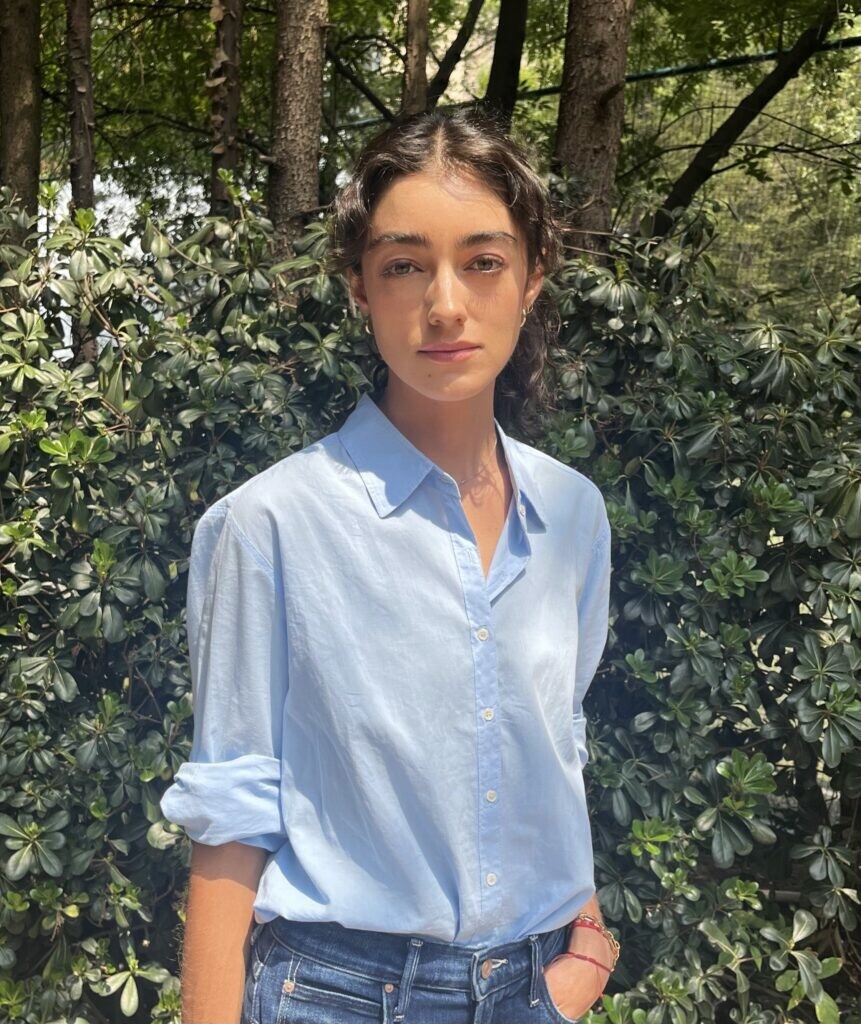
Mariana Fernández is a writer and curator. Her essays and reviews have appeared in publications like Artforum, BOMB, e-flux Criticism, frieze, Momus, and X-TRA Contemporary Art Quarterly, and in several exhibition catalogs. She is currently co-editing a bilingual book with Vic Brooks and Jennifer Burris about Alexander Calder’s Acoustic Ceiling (1954) in Caracas, Venezuela, titled Tuning Calder’s Clouds / Sintonizando las nubes de Calder. She has held previous curatorial positions at Performa, the Experimental Media and Performing Arts Center (EMPAC), and the Clark Art Institute.
Funding
The MCA DNA Research Initiative is supported by the CHANEL Culture Fund.

